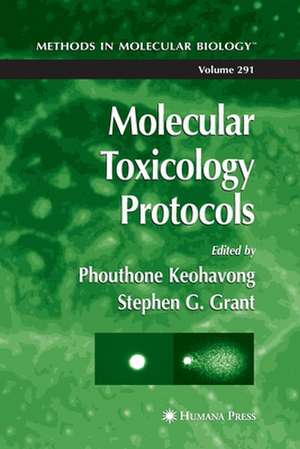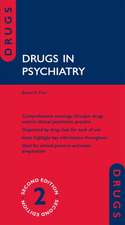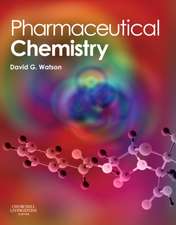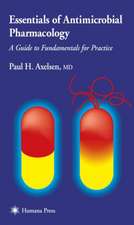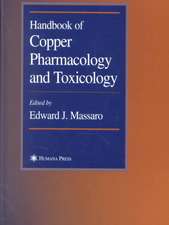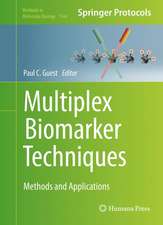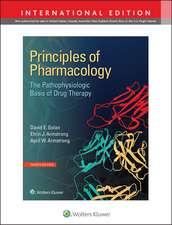Molecular Toxicology Protocols: Methods in Molecular Biology, cartea 291
Editat de Phouthone Keohavong, Stephen G. Granten Limba Engleză Paperback – 21 sep 2011
| Toate formatele și edițiile | Preț | Express |
|---|---|---|
| Paperback (2) | 1053.81 lei 43-57 zile | |
| Humana Press Inc. – 3 sep 2016 | 1053.81 lei 43-57 zile | |
| Humana Press Inc. – 21 sep 2011 | 1162.46 lei 43-57 zile | |
| Hardback (1) | 1446.82 lei 43-57 zile | |
| Humana Press Inc. – 13 mar 2014 | 1446.82 lei 43-57 zile |
Din seria Methods in Molecular Biology
- 9%
 Preț: 791.63 lei
Preț: 791.63 lei - 23%
 Preț: 598.58 lei
Preț: 598.58 lei - 20%
 Preț: 882.98 lei
Preț: 882.98 lei -
 Preț: 252.05 lei
Preț: 252.05 lei - 5%
 Preț: 802.70 lei
Preț: 802.70 lei - 5%
 Preț: 729.61 lei
Preț: 729.61 lei - 5%
 Preț: 731.43 lei
Preț: 731.43 lei - 5%
 Preț: 741.30 lei
Preț: 741.30 lei - 5%
 Preț: 747.16 lei
Preț: 747.16 lei - 15%
 Preț: 663.45 lei
Preț: 663.45 lei - 18%
 Preț: 1025.34 lei
Preț: 1025.34 lei - 5%
 Preț: 734.57 lei
Preț: 734.57 lei - 18%
 Preț: 914.20 lei
Preț: 914.20 lei - 15%
 Preț: 664.61 lei
Preț: 664.61 lei - 15%
 Preț: 654.12 lei
Preț: 654.12 lei - 18%
 Preț: 1414.74 lei
Preț: 1414.74 lei - 5%
 Preț: 742.60 lei
Preț: 742.60 lei - 20%
 Preț: 821.65 lei
Preț: 821.65 lei - 18%
 Preț: 972.30 lei
Preț: 972.30 lei - 15%
 Preț: 660.49 lei
Preț: 660.49 lei - 5%
 Preț: 738.41 lei
Preț: 738.41 lei - 18%
 Preț: 984.92 lei
Preț: 984.92 lei - 5%
 Preț: 733.29 lei
Preț: 733.29 lei -
 Preț: 392.60 lei
Preț: 392.60 lei - 5%
 Preț: 746.26 lei
Preț: 746.26 lei - 18%
 Preț: 962.66 lei
Preț: 962.66 lei - 23%
 Preț: 860.22 lei
Preț: 860.22 lei - 15%
 Preț: 652.64 lei
Preț: 652.64 lei - 5%
 Preț: 1055.50 lei
Preț: 1055.50 lei - 23%
 Preț: 883.87 lei
Preț: 883.87 lei - 19%
 Preț: 491.89 lei
Preț: 491.89 lei - 5%
 Preț: 1038.86 lei
Preț: 1038.86 lei - 5%
 Preț: 524.16 lei
Preț: 524.16 lei - 18%
 Preț: 2122.34 lei
Preț: 2122.34 lei - 5%
 Preț: 1299.23 lei
Preț: 1299.23 lei - 5%
 Preț: 1339.12 lei
Preț: 1339.12 lei - 18%
 Preț: 1390.26 lei
Preț: 1390.26 lei - 18%
 Preț: 1395.63 lei
Preț: 1395.63 lei - 18%
 Preț: 1129.65 lei
Preț: 1129.65 lei - 18%
 Preț: 1408.26 lei
Preț: 1408.26 lei - 18%
 Preț: 1124.92 lei
Preț: 1124.92 lei - 18%
 Preț: 966.27 lei
Preț: 966.27 lei - 5%
 Preț: 1299.99 lei
Preț: 1299.99 lei - 5%
 Preț: 1108.51 lei
Preț: 1108.51 lei - 5%
 Preț: 983.76 lei
Preț: 983.76 lei - 5%
 Preț: 728.16 lei
Preț: 728.16 lei - 18%
 Preț: 1118.62 lei
Preț: 1118.62 lei - 18%
 Preț: 955.25 lei
Preț: 955.25 lei - 5%
 Preț: 1035.62 lei
Preț: 1035.62 lei - 18%
 Preț: 1400.35 lei
Preț: 1400.35 lei
Preț: 1162.46 lei
Preț vechi: 1223.64 lei
-5% Nou
Puncte Express: 1744
Preț estimativ în valută:
222.47€ • 231.40$ • 183.66£
222.47€ • 231.40$ • 183.66£
Carte tipărită la comandă
Livrare economică 14-28 aprilie
Preluare comenzi: 021 569.72.76
Specificații
ISBN-13: 9781617373473
ISBN-10: 1617373478
Pagini: 489
Ilustrații: XIV, 489 p.
Dimensiuni: 155 x 235 x 26 mm
Greutate: 0.7 kg
Ediția:2005
Editura: Humana Press Inc.
Colecția Humana
Seria Methods in Molecular Biology
Locul publicării:Totowa, NJ, United States
ISBN-10: 1617373478
Pagini: 489
Ilustrații: XIV, 489 p.
Dimensiuni: 155 x 235 x 26 mm
Greutate: 0.7 kg
Ediția:2005
Editura: Humana Press Inc.
Colecția Humana
Seria Methods in Molecular Biology
Locul publicării:Totowa, NJ, United States
Public țintă
ResearchCuprins
Analysis of DNA Adducts.- 32P-Postlabeling Analysis of DNA Adducts.- Modification of the 32P-Postlabeling Method to Detect a Single Adduct Species as a Single Spot.- DNA Isolation and Sample Preparation for Quantification of Adduct Levels by Accelerator Mass Spectrometry.- Fluoroimaging-Based Immunoassay of DNA Photoproducts in Ultraviolet-B-Irradiated Tadpoles.- Analysis of DNA Strand Cleavage at Abasic Sites.- Detection of Chromosomal and Genome-Wide Damage.- Premature Chromosome Condensation in Human Resting Peripheral Blood Lymphocytes for Chromosome Aberration Analysis Using Specific Whole-Chromosome DNA Hybridization Probes.- Mutagen-Induced Chromatid Breakage as a Marker of Cancer Risk.- Flow Cytometric Analysis of Micronuclei in Erythrocytes.- The Comet Assay.- Computerized Image Analysis Software for the Comet Assay.- The Comet-FISH Technique.- DNA Double-Strand Break Damage and Repair Assessed by Pulsed-Field Gel Electrophoresis.- Detection and Characterization of Surrogate Gene Mutation.- Analysis of In Vivo Mutation in the Hprt and Tk Genes of Mouse Lymphocytes.- Quantifying In Vivo Somatic Mutations Using Transgenic Mouse Model Systems.- Methods for Detecting Somatic Mutations In Vitro.- Molecular Analysis of Mutations in the Human HPRT Gene.- Simultaneous Quantification of t(14;18) and HPRT Exon 2/3 Deletions in Human Lymphocytes.- The GPA In Vivo Somatic Mutation Assay.- Flow Cytometric Measurement of Mutant T Cells With Altered Expression of TCR.- Detection and Characterization of Cancer Gene Mutation.- Mutation Screening of the TP53 Gene by Temporal Temperature Gradient Gel Electrophoresis.- Analysis of K-RAS and P53 Mutations in Sputum Samples.- Allele-Specific Competitive Blocker-PCR Detection of Rare Base Substitution.- Gel-Based Nonradioactive Single-Strand Conformational Polymorphism and Mutation Detection.- Detection and Characterization of Oncogene Mutations in Preneoplastic and Early Neoplastic Lesions.- Detection of DNA Double-Strand Breaks and Chromosome Translocations Using Ligation-Mediated PCR and Inverse PCR.- Analysis of DNA Repair Mechanisms.- Microsatellite Instability.- Unscheduled DNA Synthesis.- Analysis of DNA Repair Using Transfection-Based Host Cell Reactivation.- An Immunoassay for Measuring Repair of Ultraviolet Photoproducts.- Analysis of DNA Double-Strand Break Repair by Nonhomologous End Joining in Cell-Free Extracts From Mammalian Cells.- Measuring Recombination Proficiency in Mouse Embryonic Stem Cells.- Array Technologies.- Strategies for Measurement of Biotransformation Enzyme Gene Expression.- Genotyping Technologies.- TaqMan® Fluorogenic Detection System to Analyze Gene Transcription in Autopsy Material.- Development of Quantitative Reverse Transcriptase PCR Assays for Measuring Gene Expression.- Apoptosis.- Quantification of Selective Phosphatidylserine Oxidation During Apoptosis.- Quantitative Method of Measuring Phosphatidylserine Externalization During Apoptosis Using Electron Paramagnetic Resonance Spectroscopy and Annexin-Conjugated Iron.- Detection of Programmed Cell Death in Cells Exposed to Genotoxic Agents Using a Caspase Activation Assay.
Recenzii
"This book should be of interest to both specialist researchers as well as members of the wider scientific community..." - British Journal of Anesthesiology
Textul de pe ultima copertă
New state-of-the-art molecular techniques promise to transform the field of genetic toxicology by making it possible to directly detect genotoxic exposures and their consequences in humans, to identify the agent(s) involved, and to clinically manage the exposed population. In Molecular Toxicology Protocols, researchers from prominent universities and cancer centers around the world describe in detail their best techniques for analyzing genotoxic exposure and the resulting biological effects, including intermediate biomarkers such as DNA and chromosomal damage, mutations in reporter and oncogenes, and the earliest possible detection of cancer. The authors emphasize analytical methods specifically developed for use in human populations and in cancer patients, or in other in vivo systems such as transgenic mice. Among the applications detailed are the analysis of interactions of chemical and physical agents with cellular macromolecules, especially DNA, the assessment of medically relevant toxicity, and the individualized characterization of genetic damage and repair. There are also methods to assess and characterize the modulation of this damage and repair through individual differences in specific and genome-wide gene expression, including metabolic profiling and apoptotic capacity. These methods mark a shift in emphasis from studies of the agents themselves to the exposed population, and from studies of small populations with significant known exposures to a single agent, to studies of common diseases, such as breast cancer, caused by normal levels of generalized genotoxic exposure. The protocols follow the successful Methods in Molecular Biology™ series format, each offering step-by-step laboratory instructions, an introduction outlining the principle behind the technique, lists of the necessary equipment and reagents, and tips on troubleshooting and avoiding known pitfalls.
Comprehensive and highly practical, Molecular Toxicology Protocols offers agold-standard collection of cutting-edge techniques designed to investigate a broad range of exposures-endogenous, accidental, medical, environmental, and occupational-and their role in human carcinogenesis and other diseases of aging.
Comprehensive and highly practical, Molecular Toxicology Protocols offers agold-standard collection of cutting-edge techniques designed to investigate a broad range of exposures-endogenous, accidental, medical, environmental, and occupational-and their role in human carcinogenesis and other diseases of aging.
Caracteristici
Includes supplementary material: sn.pub/extras
